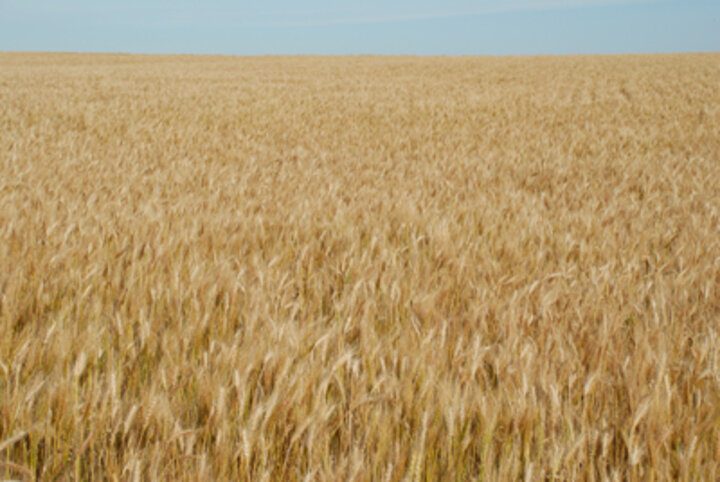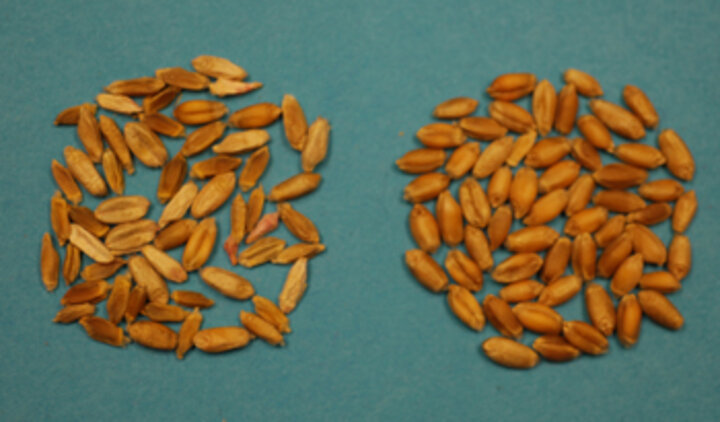
|

|
| Figure 1. White wheat heads caused by scab in a field in Webster County, June 20. | Figure 2. Wheat severely infected by scab in a pivot corner in Saline County, June 21. |
June 22, 2007
Wheat Disease Update

|
| Figure 3. An irrigated wheat field in Perkins County in southwestern Nebraska showing scab symptoms, June 19. |
Heavy rains prior to and during flowering caused widespread occurrence of wheat scab (Fusarium head blight) in Nebraska this year. Wheat fields in south central and eastern Nebraska have some level of scab, ranging from moderate (Figure 1) to severe (Figure 2). On June 19, scab was confirmed in irrigated wheat fields in Keith and Perkins counties in southwestern Nebraska (Figure 3).
Scabby wheat heads are bleached white and can be distinguished from healthy heads even in fields where the crop has dried down and is ready for harvest (Figure 1). A pink discoloration (Figure 4) on some scabby heads represents spore masses of Fusarium, the fungus that causes scab.
Scabby kernels can be shriveled or appear chalky white or pink (Figure 5). These kernels are lighter than healthy kernels and may contain vomitoxin (deoxynivalenol or DON). Grain from fields with scab will most likely be tested for presence of DON before acceptance at the elevator and may be rejected if DON levels exceed advisory levels established by the Food and Drug Administration.
Recommendations for this Year
-

Figure 4. Scabby wheat kernels (left) and healthy kernels. - Grain quality can be improved by increasing fan speed during harvest to blow out the lighter scabby kernels.
- Harvest and store grain from severely affected parts of the field separately.
- The moisture content of scabby grain should be about 12% before storage and should be maintained at that level to avoid deterioration of grain from fungus growth.
- Consider cleaning scabby grain. Cleaning can be achieved with air, screens, or a gravity table. To justify cleaning, the price of cleaned grain minus cleaning costs should exceed the price of scabby grain.
- Do not burn crop residue as this practice will not eliminate soil borne pathogens, depletes the soil of nitrogen and increases the risk of wind erosion.
Recommendations for Next Growing Season
- In the fall, plant certified, fungicide-treated seed. If grain from fields with scab must be used as seed, treat it with fungicide before planting. Planting fungicide-treated seed will not prevent scab on wheat heads, but will protect the seedlings from seedling blights caused by the scab fungus and other soil-borne fungi.
- Avoid planting wheat into corn stubble. The scab fungus causes stalk rots in corn and, although the fungus can survive on stubble of small grains and some grasses, it survives best on corn stubble.
- Avoid planting wheat cultivars that are highly susceptible. No cultivars are highly resistant; however, some cultivars have good levels of tolerance.
- Consider applying a fungicide at the beginning of flowering if weather conditions favor development of scab. Fungicides registered for control of scab include prothioconazole (Proline), propiconazole (Tilt) and tebuconazole (Folicur) which had a Section 18 emergency exemption this year.
For more information on wheat scab and how to manage the disease and the associated vomitoxin, see the June 15 Crop Watch article "Wheat Scab (Fusarium Head Blight) Widespread in South Central and Eastern Nebraska" and an article by Dr. Marcia McMullen et al., "Dealing With Scabby Grain, Vomitoxin" (http://www.ndsu.nodak.edu/plantpath/scabbygrain.htm)
Stephen Wegulo
Extension Plant Pathologist
Randy Pryor
Extension Educator in Saline County
